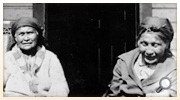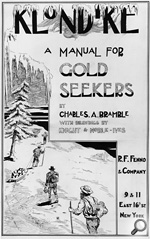
In mid-August, 1896, an American prospector named George Carmack, his wife Kate Carmack (Shaaw Tláa), her brother Skookum Jim (Keish) and their nephew Dawson Charlie (Káa Goox) were travelling through the area south of the Klondike River. Resting by the side of a small stream that the miners called Rabbit Creek, one of them noticed a metallic glitter in the creek. They had found gold.
The next morning, August 17, they staked their claims. Carmack took credit for the find, staking the discovery claim — the first claim on the creek — which entitled him to a second claim. They registered the claims at Forty Mile on September 24, within the 60 days required by mining regulations. The closest mining recorder was at Forty Mile, 80 km away.

Ellen Silas (Tsà àn t’lik) and Ellen Woods (Tsòn gé) making birchbark baskets, n.d. Dawson City was established at the mouth of the Klondike River, on land traditionally occupied by the Tr’ondëk Hwëch’in.
Yukon Archives, Brian and Martha Kates collection, #5773

First Nations packers and others at the Healy and Wilson post in Dyea, Alaska, at the foot of the Chilkoot Trail, 1898. According to William Ogilvie, some years before the gold rush the two traders cut a pack trail along the Chilkoot route from their post to Sheep Camp.
Yukon Archives, Anton Vogee fonds, #103

Skookum Jim, also known as Tagish Jim, staked 1 Above — upstream from — Discovery, and Dawson Charlie staked 2 Below. Although Carmack was widely credited as the discoverer, Skookum Jim was probably the one who actually found the gold.
Yukon Archives, GOV 182, p.434
News of their discovery raced down the Yukon River. Miners abandoned their claims on Fortymile and Sixtymile creeks and Circle City, rushing to the Klondike and staking any ground they could find on the stream — soon renamed Bonanza — and its tributaries, as well as other creeks in the district. A small townsite, Dawson City, started to develop at the confluence of the Yukon and Klondike rivers.
It was a year before the news reached the outside world. The gold that was mined that first winter couldn’t be shipped out until June, 1897, when the navigation season opened. The miners and their rich cargo travelled downriver from Dawson to St. Michael, at the mouth of the Yukon River, where they boarded ocean steamers Excelsior and Portland for the journey down the west coast.
The Excelsior arrived in San Francisco on July 17 with a cargo of half a million dollars in gold, igniting public interest. By the time the Portland docked in Seattle three days later, a huge crowd was waiting for it on the wharf; an enterprising reporter named Beriah Brown of the Seattle Post-Intelligencer had taken a tugboat to intercept the Portland and telegraphed ahead. A newspaper headline trumpeting “half a ton of gold” was actually an understatement; the ship was carrying more than a ton of gold, worth a million dollars. As one contemporary writer phrased it, news of the wealth aboard the Portland “set Seattle stark mad, and the craze has spread over the civilized earth.”
Men, and even women, talk of little else.
Official Guide to the Klondike Country

People found it almost impossible to obtain accurate information about the Klondike in the early part of the rush. It probably wouldn’t have mattered if they did; as journalist Tappan Adney wrote in The Klondike Stampede, “...not one in ten, or a hundred, knew what the journey meant nor heeded the voice of warning.”
University of Washington Libraries, Special Collections AWC0067

By November 20, 1896, 338 claims had been recorded in the Klondike.
Yukon Archives, Gillis family fonds, #4512




